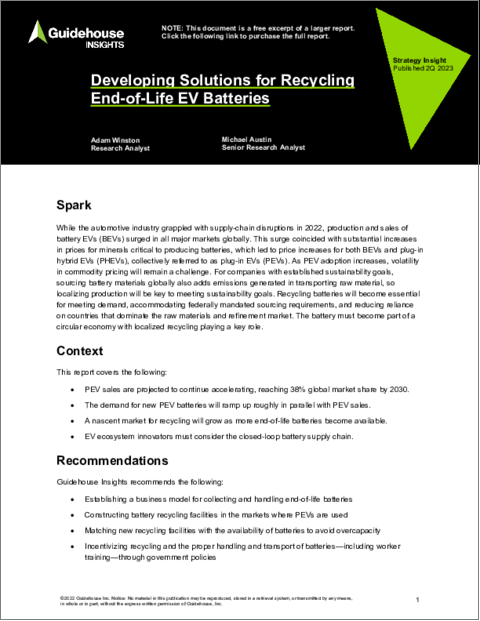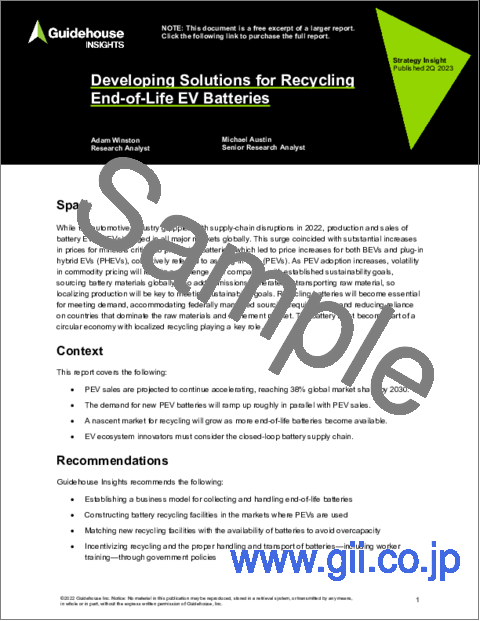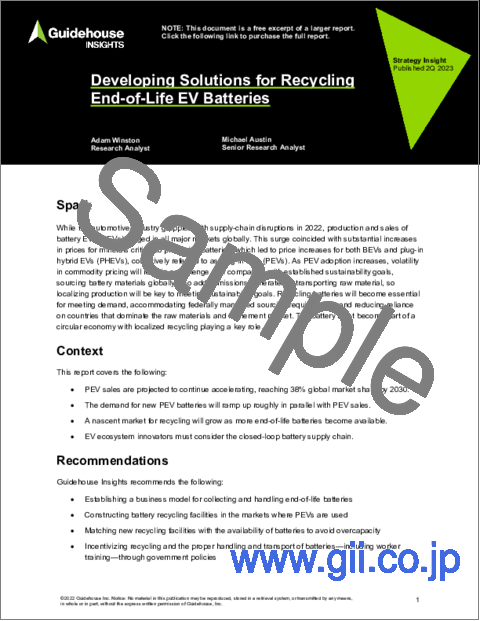|
|
市場調査レポート
商品コード
1296108
EV用使用済みバッテリーの再生ソリューションの開発Developing Solutions for Recycling End-of-Life EV Batteries |
||||||
|
|||||||
| EV用使用済みバッテリーの再生ソリューションの開発 |
|
出版日: 2023年06月20日
発行: Guidehouse Research
ページ情報: 英文 19 Pages; 13 Tables, Charts & Figures
納期: 即納可能
|
- 全表示
- 概要
- 図表
- 目次
プラグインEV (PEV) の販売台数は、2022年に1,040万台に達した後、2030年には5,700万台まで加速し、世界市場シェアは47%に達すると予測されています。PEVの販売と並行してPEV用電池の需要も増加します。増え続けるPEV用バッテリーはいずれ耐用年数を迎え、環境目標や規制・政策に違反するような埋立地への廃棄に代わる解決策が必要になります。電池の再生 (リサイクル) は、使用済みPEVバッテリーの実行可能な解決策と考えられています。それは環境的に持続可能であり、一握りの国が支配する材料の抽出・精製への依存を減らすことによって、国際的なサプライチェーンと地政学的リスクを軽減するという、政府と業界の幅広い戦略目標を満たすものです。
北米の小型PEVの販売台数は2030年までに660万台に達すると推定されており、PEV用バッテリーの再生は、主要なバッテリー材料の95%~98%が回収可能で、新しいバッテリーの生産に回すことができる閉ループのサプライチェーンにこれらの材料を維持するための戦略的ソリューションとみなされています。最低10年の寿命を想定すると、2021年に販売されたPEVの台数である66万7,000台近くのPEVバッテリーが、2031年までに米国で再生可能となります。
当レポートでは、世界のEV用・使用済みバッテリーの再生ソリューションの開発動向について分析し、PEV市場の見通し (PEVの販売台数、PEV用バッテリーの生産個数、リサイクル可能なPEVバッテリーの潜在量など) や、PEVバッテリーの再生市場を確立するための潜在的なビジネスモデルの概要、使用済みPEVバッテリーの安全な撤去・排出・ハンドリング・再生施設への輸送を確保するための主要なインセンティブと規制、といった情報を取りまとめてお届けいたします。
目次
序文
背景
提言
PEVの販売の増加傾向:バッテリーも必要となる
世界のEV販売台数:過去5年間で大幅に増加
EVの販売が世界のバッテリー需要を牽引
バッテリーの市場規模:米国のEV販売にどう影響するのか?
米国・カナダのバッテリー需要:供給に追い付かない可能性
米国のEVバッテリー再生市場の成長見通し
EVバッテリーの再生プロセス:複数の利点
EVバッテリー再生における材料の評価
再生コストの正当化
使用済みEVバッテリーの輸送
将来のバッテリーコストが、再生バッテリーとの競合を左右する
規制・政策・ビジネスモデル:リサイクル市場に及ぼす影響
EVエコシステムのイノベーター:閉ループ型のバッテリー・サプライチェーンを考慮する必要性
コアチャージ:EVバッテリーにとって問題となる可能性
リサイクル業者が使用済みバッテリーの代金を支払う可能性
メーカーが使用済みバッテリーの回収費用を負担する可能性
バッテリーをリースできる可能性
その他のインセンティブ・規制の必要性
List of Tables
Potential Recyclable Commodity Value by Type of Battery Composition
List of Figures
- EV Sales, Percentage of Vehicles Sales, and Number of EV Batteries Available for Recycling, Worldwide, 2022-2031
- Global BEV and PHEV Sales by Region, Worldwide, 2022-2031
GWh of Battery Production in 2022 and Battery Capacity Needed for 2030 Battery Demand
- EV Sales, Percentage of Vehicles Sales, and Number of EV Batteries Available for Recycling, US, 2022-2031
Cathode Supply Chain
US EV Battery Demand for Stated Policies, Sustainable Development, and Average Scenarios with a Range of EV Batteries Available for Recycling: Low (25%), Base (50%), and High (75%)
EV Recycled Batteries as a Percentage of 2025 and 2030 Base and High Production Levels for High (75%), Base (50%), and Low (25%) EV Battery Recycling Scenarios
Lifecycle of an EV Battery: Refurbishing and Re-Introduction into the Manufacturing Process
Hydrometallurgy Extraction and Cathode Production Process
Hydro-to-Cathode Extraction and Production Process
Recycling Facilities and State Regulatory Environments
IRA Stipulations for Raw Mineral Battery Composition Requirements from the US or Countries with an FT
Plug-in EV (PEV) sales, which reached 10.4 million in 2022, are projected to accelerate to 57 million vehicles by 2030, a global market share of 47%. Demand for PEV batteries will increase in parallel with PEV sales. An increasing number of PEV batteries will eventually reach the end of their useful life and require an alternative solution to being discarded into landfills, which violates environmental goals, policies, and regulations. Recycling is considered a viable solution for end-of-life PEV batteries. It is environmentally sustainable and it meets broad government and industry strategic goals of mitigating international supply chain and geo-political risks by decreasing reliance on material extraction and refinement dominated by a handful of countries.
North American light duty PEV sales are estimated to reach 6.6 million units by 2030 and PEV battery recycling is viewed as a strategic solution to keep these materials in a closed-loop supply chain in which 95% to 98% of key battery materials are recoverable and can be directed into new battery production. Assuming a minimum 10-year lifespan, nearly 667,000 PEV batteries—the number of PEVs sold in 2021—will be available for recycling in the US by 2031.
This Guidehouse Insights report presents forecasts for future PEV sales, PEV battery production, and the potential volume of PEV batteries available for recycling. It includes an overview of potential business models for establishing a PEV battery recycling market and identifies key incentives and regulations that could ensure the safe removal, discharge, handling, and transportation of end-of-life PEV batteries to recycling facilities.
Table of Contents
Spark
Context
Recommendations
PEVs Sales Are On The Rise and They Need Batteries
Global EV Sales Have Grown Significantly in the Last Five Years
EV Sales Drive Global Battery Demand
What Does the Battery Market Size Mean for US EV Sales?
US and Canada Battery Demand Could Lag Supply
The EV Battery Recycling Market in the US Is Forecast to Grow
The EV Battery Recycling Process Has Multiple Benefits
Valuing Materials from EV Battery Recycling
Justifying Recycling Costs
Transporting Used EV Batteries
Future Battery Costs Will Determine Competition with Recycled Batteries
Regulations, Policies, and Business Models Affect the Recycling Market
EV Ecosystem Innovators Must Consider the Closed-Loop Battery Supply
Chain
Core Charges Could Be Problematic for EV Batteries
Recyclers Could Pay for End-of-Life Batteries
Manufacturers Could Pay for Collecting End-of-Life Batteries
Batteries Could Be Leased
Other Incentives and Regulations Are Needed





